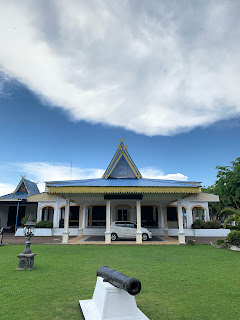Bengkalis Tradisional House
Bengkalis Traditional House: Forgotten Cultural Wealth
Bengkalis, a district in Riau Province, Sumatra, has diverse cultural riches, one of which is its traditional houses. Unfortunately, traditional houses in Bengkalis are rarely exposed and widely known. Below is some information about traditional houses in Bengkalis that deserve more attention.
Architecture and Structure
Traditional houses in Bengkalis are generally built with natural materials such as wood and bamboo. The wood used usually comes from local trees which are resistant to pest attacks and tropical weather. The structure of this house was designed to adapt to the local environment which has a tropical climate and tends to be wet. This house was built in 1818. In that year Bengkalis was still the territory of the Siak Sri Indrapura Kingdom during the reign of Sultan Tengku Syed Ibrahim. According to information from the Head of Culture, Bengkalis Regency Tourism and Culture Office.
The main characteristic of a traditional Bengkalis house is its steep and high roof, made of palm fiber or palm grass leaves. This steep roof shape functions to channel rainwater quickly, so that it does not pool and damage the structure of the house.
Design and Spatial Planning
The design of traditional Bengkalis houses reflects the cultural values of the local community. This house usually consists of several parts, including:
1. Porch: The front of the house which is used to receive guests and a place to relax with the family.
2. Central Room: This section functions as the main room for daily activities and also a place for family gatherings.
3. Kitchen: The kitchen is usually located at the back of the house and is used for cooking food and storing food ingredients.
4. Bedroom: Bedrooms are usually located inside the house, providing privacy for those who occupy the house.
Every room in a traditional Bengkalis house is designed with attention to air flow and natural lighting, so that the house remains cool and comfortable even without the use of modern technology.
Local wisdom
Bengkalis traditional houses are not just places to live, but also reflect the local wisdom and cultural values of the people. For example, the use of natural, environmentally friendly materials shows respect for nature. In addition, construction techniques passed down from generation to generation also indicate a wealth of architectural skills and knowledge.
Conservation Challenges and Efforts
Currently, Bengkalis traditional houses face various challenges. Modernization and changes in lifestyle have made many people switch to houses with modern designs. Lack of documentation and promotion also means that many of these traditional houses are little known to the younger generation and tourists.
To preserve this cultural wealth, efforts are needed from various parties, including government, society and cultural institutions. The establishment of a museum or cultural information center, as well as promotion through social media and tourism, can be effective steps to introduce and preserve traditional Bengkalis houses.
Conclusion
Bengkalis traditional houses are an important part of cultural heritage that should be preserved. With unique architecture and rich cultural values, these houses are not only silent witnesses to history, but also a reflection of the local wisdom of the Bengkalis people. It is time for Bengkalis traditional houses to receive greater attention so that they are not lost to time.




Komentar
Posting Komentar